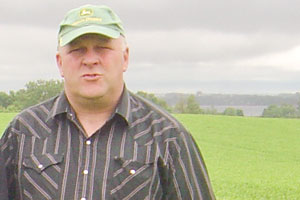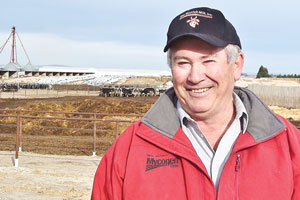Will you try anything different this year? When you do you anticipate planting?
The responses were somewhat varied, but a common theme was knowing what you already have by doing soil tests and then applying what you need to meet crop requirements. What has been successful for you? E-mail your answers to editor@progressiveforage.com and we’ll share them in an upcoming issue.
Jeff Handschke
Sugar Creek Dairy • New London, Wisconsin
We use primarily cow manure here; purchased fertilizer is at a minimum. We used to split-apply some of our nitrogen with 32 percent side-dressed, but after getting burned by last year’s wet weather, we are going to put all nitrogen needs out early.
Being that we are primarily a dairy farm, we have plenty of phosphorus (P). We purchased and applied 85 percent of our potash last fall as a cost and time saver this spring. I have noticed the biggest yields for silage always come off my fields with the highest P levels.
As for planting, we usually watch soil temperatures. If it gets to 40 and there is a warm stretch coming, I will start planting about 15 percent of our acres. Last year we started in our area about April 12th. It ended up being some of the best corn in the area, so the gamble paid off.
Rodney Elliott
Drumgoon Dairy • Lake Norden, South Dakota
We have a lot of animals that produce a lot of waste, so we need to maximize the nutrients available for use there on the farm. It’s certainly the cheapest and most cost-effective way for us to grow forages.
We do a lot of fall applications (about 97 percent in liquid form), but we’ll also put some compost on some fields this spring. Hopefully we won’t need too many commercial fertilizers to get our crops up and growing.
We’ve also done quite a bit of education with farmers around us to get them competing for the excess nutrients we can’t use on our own fields, and that has worked out well for all of us.
Planting in our area we hope to see in about the last 10 days of April. Last year it was around the 25th of April, but if we go into the first of May, it won’t really scare anybody, either.
Scott Reiland
Reiland Farms • LeRoy, Minnesota
We want our fertility to be at the right level, so we’re not compromising tonnage when it comes to harvest. Also, a healthier plant will have higher feed value. For corn on corn ground, we shoot for 160 pounds of actual nitrogen (N), subtracting the N from past manure applications.
Generally with our manure applications we don’t need any additional phosphorus (P) and potassium (K). We usually try to apply anhydrous ammonia in the spring.
If for some reason we have a late planting, we might change to urea or a 28 percent UAN application since anhydrous requires us to wait a couple of days before planting.
We hope to get our corn in by the end of April. Last year was our earliest planting ever, getting seeds in the ground April 19 to 22.
Keith Dawydko
Anchor Farms, Inc • Clarence, New York
We work with a crop consultant and soil sample about a third of our acreage yearly. Fertilizer is based on the soil test and amount of manure applied.
We set a yield goal that we believe we can achieve and figure out how much fertilizer that crop will need to mature, then try to group fields together for a certain fertilizer program.
All of our corn is zone-tilled. Starter fertilizer is applied in a band at planting. Planter fertilizer is a dry mix of 18-18-0 or 12-24-24, with micronutrients added to the mix as needed. The remainder of the nitrogen is applied with the zone builder in the form of NH3.
When to start planting? It’s an early spring if corn is going in the ground the last week of April in our area. Last year we got started early, then around the 15th of May it snowed.
Ray Robinson
Moo Mountain Milk and East Ridge Milk • Burley, ID
We know quality silage starts with good soil. With more than 5,000 acres of forage, our operation covers a lot of ground and a wide range of soil types, so our fertilization and nutrient management program can vary greatly from year to year.
That is why it is critical for us to conduct soil tests every year. The results help us determine the best approach to take. We often end up applying more nitrogen, as our phosphate needs are pretty well covered from our manure program.
We will plant once the temperatures are warmer than 50 degrees, hopefully by April 20 to 25 at the latest, which will be earlier than last year. FG









